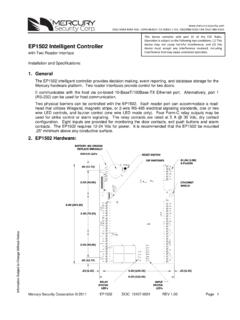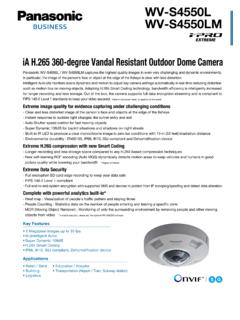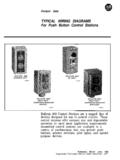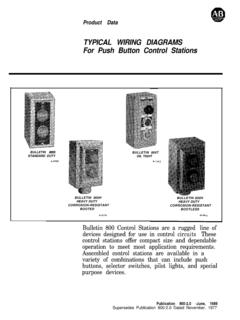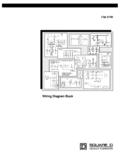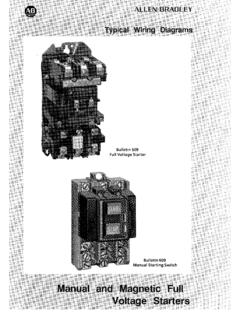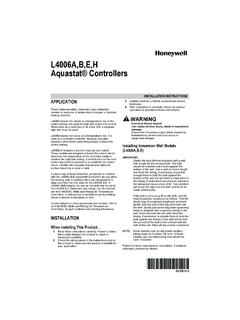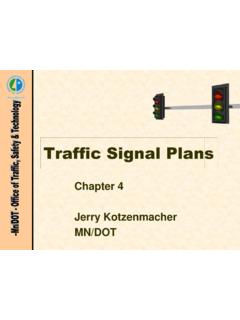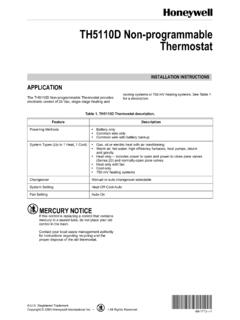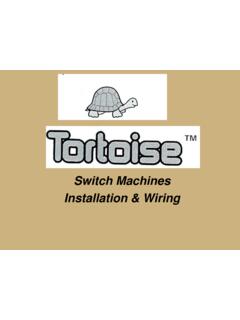Transcription of EP1501 Intelligent Controller - Panasonic
1 2355 MIRA MAR AVE. LONG BEACH, CA 90815-1755, (562)986-9105 FAX (562) 986-9205. This device complies with part 15 of the FCC Rules. EP1501 Intelligent Controller Operation is subject to the following two conditions: (1) This device may not cause harmful interference, and (2) this with Paired Reader Interface for One Physical Barrier device must accept any interference received, including interference that may cause undesired operation. Installation and Specifications: 1. General: The EP1501 Intelligent Controller provides decision making, event reporting and database storage for the Mercury hardware platform. Two reader interfaces configured as paired or alternate readers provide control for one physical barrier. Host communication is via the on-board 10-BaseT/100 Base-TX Ethernet port. Note: For UL compliance, the Power Sourcing Equipment (PSE) such as a PoE enabled network switch and/or PoE power injectors must be UL Listed under UL294B.
2 Reader port 1 can accommodate a reader that utilizes TTL (D1/D0, Clock/Data), F/2F, or 2-wire RS-485. device signaling, also provides tri-state LED control , and buzzer control (one wire LED mode only). This port can also utilize multiple 2-wire RS-485 multi-dropped devices, such as up to two readers or up to eight remote serial I/O devices. Reader port 2 can accommodate a reader that utilizes TTL (D1/D0, Clock/Data), or F/2F signaling, also provides tri-state LED control , and buzzer control (one wire LED mode only). Two Form-C contact relay outputs may be used for door strike control or alarm signaling. The relay contacts are rated at 2 A @ 30. Vdc, dry contact configuration. Two inputs are provided that may be used for monitoring the door contact, exit push button or alarm contact. Input circuits can be configured as unsupervised or supervised.
3 The EP1501 requires Power over Ethernet (PoE) or 12 Vdc for power. The EP1501 may be mounted in a 3-gang switch box; a mounting plate is supplied with the unit, or may be mounted in an enclosure; the supplied mounting plate has mounting holes that match the MR50 mounting footprint. 2. EP1501 Hardware: PoE/12 Vdc POWER SELECTOR. JUMPER (J3). [ ]..15 [ ] [ ] [ ] .15 [ ]..20 [ ]. TAMPER. SWITCH. 1 1 1 1 1. CONNECTION 12V J3. TB1 TB2 TB3 TB4 TB5. TB1. TB5. (J7). PoE. K2. J7. J4. [ ]. [ ]. K1. 7 6 5 4 3 2 1..125 [ ]. BT1. J6. 6 PL 4 3 2 1. J5 S2 S1 ETHERNET. ON J1 CONNECTOR. (J6). RESET SWITCH DIP SWITCHES STATUS LEDs CHASSIS GND .20 [ ]. RELAY K2 LED. RELAY K1 LED. SOLDER SIDE. Mercury Security 2014 EP1501 DOC 10107-0036 REV Page 1. 3. EP1501 Wiring and Setup: EP1501 CONNECTIONS. TB1-1 IN1 Input 1. TB1-2 IN1. TB1-3 IN2 Input 2. TB1-4 IN2.
4 TB2-1 VO Reader 1 Power Output 12 Vdc TB2-2 LED Reader 1 LED Output TB2-3 BZR Reader 1 Buzzer Output TB2-4 CLK Reader 1 CLK/Data 1/TR+. TB2-5 DAT Reader 1 DAT/Data 0/TR- TB2-6 GND Reader 1 Ground TB3-1 LED Reader 2 LED Output TB3-2 BZR Reader 2 Buzzer Output TB3-3 CLK Reader 2 CLK/Data 1 Input TB3-4 DAT Reader 2 DAT/Data 0 Input TB4-1 VO Auxiliary Power Output 12 Vdc TB4-2 GND Auxiliary Power Output Ground TB4-3 VIN Input Power 12 Vdc (from local power supply). TB4-4 GND Input Power Ground TB5-1 NO Relay K1 Normally Open Contact TB5-2 1-C Relay K1 Common Contact TB5-3 NC Relay K1 Normally Closed Contact TB5-4 NO Relay K2 Normally Open Contact TB5-5 2-C Relay K2 Common Contact TB5-6 NC Relay K2 Normally Closed Contact Jumpers: JUMPERS SET AT DESCRIPTION. J1 N/A Factory Use Only J2 N/A Factory Use Only J3 PoE EP1501 powered from the Ethernet connection 12V EP1501 powered from an local 12 Vdc power source connected to TB4-3 (VIN), TB4-4 (GND).
5 J4 N/A Factory Use Only J5 N/A Factory Use Only J6 N/A 10-Base-T/100 Base-TX Ethernet Connection J7 Cabinet Tamper Switch Input: short = tamper secure Mercury Security 2014 EP1501 DOC 10107-0036 REV Page 2. DIP Switches: The four switches on S1 DIP switch configure the operating mode of the EP1501 processor. DIP. switches are read on power-up except where noted. Pressing switch S2 causes the EP1501 to reboot. 1 2 3 4 Definitions OFF OFF OFF OFF Normal operating mode. After initialization, enable default User Name (admin) and ON X X X Password (password). The switch is read on the fly, no need to re- boot. See IT Security section for additional information. OFF ON X OFF Use factory default communication parameters. ON ON X OFF Use OEM default communication parameters. Contact system manufacture for details. See Bulk Erase section below.
6 X X ON X Disable TLS secure link. Switch is read only when logging on. All other switch settings are unassigned and reserved for future use. Factory Default Communication Parameters: Network: static IP address: Subnet Mask: Default Gateway: DNS Sever: Host port: IP server, no encryption, port 3001, communication address: 0. 4. Bulk Erase Configuration Memory: The bulk erase function can be used for the following purposes: Erase all configuration and cardholder database (sanitize board). Update OEM default parameters after OEM code has been changed Recover from database corruption causing EP1501 board to continuously reboot If clearing the memory does not correct the initialization problem, contact technical support. Bulk Erase Steps: Do not remove power during steps 1-8. 1. Set S1 DIP switches to: 1 & 2 "ON", 3 & 4 "OFF". 2. Apply power to the EP1501 board.
7 3. Watch for LEDs 1 & 2 and 3 & 4 to alternately flash at a second rate. 4. Within 10 seconds of powering up, change switches 1 or 2 to "OFF". If these switches are not changed, the EP1501 board will power up using the OEM default communication parameters. 5. LED 2 will flash indicating that the configuration memory is being erased. 6. Full memory erase takes up to 60 seconds. 7. When complete, only LEDs 1 & 4 will flash for 8 seconds. 8. The EP1501 board will reboot 8 seconds after LEDs 1 & 4 stop flashing (no LEDs are on during this time). 5. Input Power: The EP1501 is powered by one of two ways (jumper selected, J3): Power is supplied via the Ethernet connection using PoE, fully compliant to IEEE Or local 12 Vdc power supply, TB4-3 (VIN), TB4-4 (GND). 6. Communication Wiring: The EP1501 Controller communicates to the host via the on-board 10-BaseT/100 Base-TX Ethernet interface.
8 Mercury Security 2014 EP1501 DOC 10107-0036 REV Page 3. 7. Reader/Serial I/O Device Wiring: Reader port 1 supports TTL (D1/D0, Clock/Data), F/2F, or 2-wire RS-485 device(s). Reader port 2. supports TTL (D1/D0, Clock/Data), or F/2F. Power to reader port 1 is 12 Vdc at 180 mA maximum. The reader connected to reader port 2 may be powered from the 12 Vdc auxiliary power supply output; TB4-1. and TB4-2. Readers that require different voltage or have high current requirements should be powered separately. Refer to the reader manufacture specifications for cabling requirements. In the 2-wire LED. mode, the buzzer output is used to drive the second LED. Reader port configuration is set via the host software. Reader port 1 can support up to eight 2-wire RS-485 remote serial I/O devices using MSP1 protocol or up to two OSDP devices. If two OSDP devices are used, reader port 2 will not support a third reader.
9 If only one OSDP device is configured, then reader port 2 is available for a second reader. The maximum cable length is 2000 ft. (610 m). Do not terminate any RS-485 devices connected to reader port 1. When powering remote device(s) from the EP1501 , be cautious not to exceed the maximum current limit. Cable gauge must also be evaluated. See specifications section for details. Reader Wiring Diagrams: SECOND READER PORT. FIRST READER PORT. TB3. 1. TB2. 1. LED. VO (12 Vdc) BZR. LED CLK/D1. BZR DAT/D0. (12 Vdc). CLK/D1 TB4. 1. DAT/D0 VO. GND GND. VIN. GND. Reader Port 1 Reader Port 2. Typical D1/D0 or Clock/Data Reader Typical D1/D0 or Clock/Data Reader FIRST READER PORT SECOND READER PORT. TB2. 1. +12 Vdc TB3. 1. VO (12 Vdc). LED LED. DO (GREEN LED) DO (GREEN LED). BZR BZR. D1 D1. CLK/D1 CLK/D1. DAT/D0 DAT/D0. GROUND. GND TB4. 1.
10 +12 Vdc VO. GROUND. GND. VIN. GND. F/2F Reader F/2F Reader Reader Port 1 Reader Port 2. Typical Unsupervised F/2F Reader Typical Unsupervised F/2F Reader Mercury Security 2014 EP1501 DOC 10107-0036 REV Page 4. * Inputs on supervised F/2F readers may be unsupervised or supervised (supervised shown). FIRST READER PORT. SECOND READER PORT. TB2. 1. +12 Vdc +12 Vdc TB3. 1. VO (12 Vdc). LED. LED DO (GREEN LED). DO (GREEN LED) BZR. BZR D1. D1 CLK/D1. CLK/D1 DAT/D0. DAT/D0 GROUND. GROUND TB4. 1. GND. VO 1K,1%. 1K,1% GND. VIN 1K,1%. 1K,1% GND 1K,1%. DOOR MONITOR SWITCH. NORMALLY CLOSED CONTACT * 1K,1%. 1K,1%. F/2F Reader 1K,1% DOOR MONITOR SWITCH. NORMALLY CLOSED CONTACT *. F/2F Reader REQUEST TO EXIT SWITCH. NORMALLY OPEN CONTACT * REQUEST TO EXIT SWITCH. NORMALLY OPEN CONTACT *. Reader Port 1 Reader Port 2. Typical Supervised F/2F Reader Typical Supervised F/2F Reader Jumper D1 and LED on supervised F/2F readers REFER TO THE APPROPRIATE REMOTE SERIAL I/O DEVICE INSTALLATION MANUAL FOR ADDRESS.
